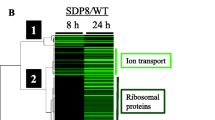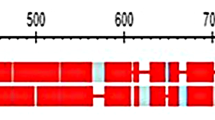Abstract
Genes involved in storage carbohydrate metabolism are coordinately induced when yeast cells are subjected to conditions of stress, or when they exit the exponential growth phase on glucose. We show that the STress Responsive Elements (STREs) present in the promoter of GSY2 are essential for gene activation under conditions of stress, but dispensable for gene induction and glycogen accumulation at the diauxic shift on glucose. Using serial promoter deletion, we found that the latter induction could not be attributed to a single cis -regulatory sequence, and present evidence that this mechanism depends on combinatorial transcriptional control by signalling pathways involving the protein kinases Pho85, Snf1 and PKA. Two contiguous regions upstream of the GSY2 coding region are necessary for negative control by the cyclin-dependent protein kinase Pho85, one of which is a 14-bp G/C-rich sequence. Positive control by Snf1 is mediated by Mig1p, which acts indirectly on the distal part of the GSY2 promoter. The PKA pathway has the most pronounced effect on GSY2, since transcription of this gene is almost completely abolished in an ira1ira2 mutant strain in which PKA is hyperactive. The potent negative effect of PKA is dependent upon a branched pathway involving the transcription factors Msn2/Msn4p and Sok2p. The SOK2 branch was found to be effective only under conditions of high PKA activity, as in a ira1ira2 mutant, and this effect was independent of Msn2/4p. The Msn2/4p branch, on the other hand, positively controls GSY2 expression directly through the STREs, and indirectly via a factor that still remains to be discovered. In summary, this study shows that the transcription of GSY2 is regulated by several different signalling pathways which reflect the numerous factors that influence glycogen synthesis in yeast, and suggests that the PKA pathway must be deactivated to allow gene induction at the diauxic shift.










Similar content being viewed by others
References
Anderson C, Tatchell K (2001) Hyperactive glycogen synthase mutants of Saccharomyces cerevisiae suppress the glc7-1 protein phosphatase mutant. J Bacteriol 183:821–829
Andrews B, Measday V (1998) The cyclin family of budding yeast: abundant use of good idea. Trends Genetics 14:66−71
Berben G, Dumont J, Gilliquet V, Bolle PA, Hilger F (1991) The YDp plasmids: a uniform set of vectors bearing versatile gene disruption cassettes for Saccharomyces cerevisiae. Yeast 7:475–487
Boy-Marcotte E, Perrot M, Bussereau F, Boucherie H, Jacquet M (1998) Msn2p and Msn4p control a large number of genes induced at the diauxic transition which are repressed by cyclic AMP in Saccharomyces cerevisiae. J Bacteriol 180:1044–1052
Cannon JF, Pringle JR, Fiechter A, Khalil M (1994) Characterization of glycogen-deficient glc mutants of Saccharomyces cerevisiae. Genetics 136:485–503
Causton HC, Ren B, Koh SS, Harbison CT, Kanin E, Jennings EG, Lee TI, True HL, Lander ES, Young RA (2001) Remodeling of yeast genome expression in response to environmental changes. Mol Biol Cell 12:323–337
DeRisi JL, Iyer VR, Brown, PO (1997) Exploring the metabolic and genetic control of gene expression on a genomic scale. Science 278:680–686
Enjalbert B, Parrou JL, Vincent O, François J (2000) Mitochondrial respiratory mutants of Saccharomyces cerevisiae accumulate glycogen, and readily mobilize it upon glucose depletion. Microbiology 146:2685–2694
Estruch F (2000) Stress-controlled transcription factors, stress-induced genes and stress tolerance in budding yeast. FEMS Microbiol Rev 24:469–486
Farkas I, Hardy TA, Goebl MG, Roach PJ (1991) Two glycogen synthase isoforms in Saccharomyces cerevisiae are coded by distinct genes that are differentially controlled. J Biol Chem 266:15602–15607
François J, Parrou JL (2001) Reserve carbohydrates in the yeast Saccharomyces cerevisiae. FEMS Microbiol Rev 25:125–145
François J, Villanueva ME, Hers HG (1988) The control of glycogen metabolism in yeast. I. In vivo interconversion of glycogen synthase and glycogen phosphorylase induced by glucose, a nitrogen, source and uncouplers. Eur J Biochem 174:551–559
Gancedo J M (1998) Yeast carbon catabolite repression. Microbiol Mol Biol Rev 62:334–361
Görner W, Durchschlag E, Martinez PM, Estruch F, Ammerer G, Hamilton B, Ruis H, Schuller C (1998) Nuclear localization of the C2H2 zinc finger protein Msn2p is regulated by stress and protein kinase A activity. Genes Dev 12:586–597
Hardy TA, D. Huang D, Roach PJ (1994) Interactions between cAMP-dependent and SNF1 protein kinases in the control of glycogen accumulation in Saccharomyces cerevisiae. J Biol Chem 269:27907–27913
Huang D, Farkas I, Roach PJ (1996) Pho85p, a cyclin-dependent protein kinase, and the Snf1p protein kinase act antagonistically to control glycogen accumulation in Saccharomyces cerevisiae. Mol Cell Biol 16:4357–4365
Huang D, Moffat J, Wilson WA, Moore L, Cheng C, Roach PJ, Andrews B (1998) Cyclin partners determine Pho85 protein kinase substrate specificity in vitro and in vivo: control of glycogen biosynthesis by Pcl8 and Pcl10. Mol Cell Biol 18:3289–3299
Innis MA, Gelfand DH, Sinsky JJ, White TJ (1990) PCR protocols: a guide to methods and applications. Academic Press, New-York, pp 177–183
Lenburg ME, O’Shea EK (1996) Signaling phosphate starvation. Trends Biochem Sci 21:383−387
Moriya H, Shimuzu-Yoshida Y, Omori A, Iwashita S, Katoh M, Sakai A (2001) Yak1p, a DYRK family kinase, translocates to the nucleus and phosphorylates yeast Pop2p in response to a glucose signal. Genes Dev 15:1217–1228
Nehlin JO, Ronne H (1990) Yeast MIG1 repressor is related to the mammalian early growth response and Wilms’ tumor finger proteins. EMBO J 9:2891–2898
Ni HT, LaPorte DC (1995) Response of a yeast glycogen synthase gene to stress. Mol Microbiol 16:1197–1205
Parrou JL, Teste MA, François J (1997) Effects of various types of stress on the metabolism of reserve carbohydrates in Saccharomyces cerevisiae: genetic evidence for a stress-induced recycling of glycogen and trehalose. Microbiology 143:1891–1900
Parrou JL, Enjalbert B, Plourde L, Bauche A, Gonzalez B, François J (1999a) Dynamic responses of reserve carbohydrate metabolism under carbon and nitrogen limitations in Saccharomyces cerevisiae. Yeast 15:191–203
Parrou JL, Enjalbert B, François J (1999b) STRE and cAMP-independent transcriptional induction of Saccharomyces cerevisiae GSY2 encoding glycogen synthase during diauxic growth on glucose. Yeast 15:1471–1484
Pastor-Martinez MT, Marchler G, Schüller C, Marchler-Bauer A, Ruis H, Estruch F (1996) The Saccharomyces cerevisiae zinc finger proteins Msn2p and Msn4p are required for transcriptional induction through the stress-response element (STRE). EMBO J 15:2227−2235
Pedruzzi I, Bürckert N, Egger P, de Virgilio C (2000) Saccharomyces cerevisiae Ras/cAMP pathway controls post-diauxic shift element-dependent transcription through the zinc finger protein Gis1. EMBO J 19:2569–2579
Rose M, Botstein D (1983) Construction and use of gene fusions lacZ (β-galactosidase) which are expressed in yeast. Methods Enzymol 101:167–180
Rose MD, Winston F, Hieter P (1990) Methods in yeast genetics: a laboratory course manual. Cold Spring Harbor Laboratory Press, Cold Spring Harbor, N.Y.
Schmelzle T, Beck T, Martin DE, Hall MN (2004) Activation of the RAS/cyclic AMP pathway suppresses a TOR deficiency in yeast. Mol Biol Cell 24:338 –351
Shenhar G, Kassir Y (2001) A positive regulator of mitosis, Sok2, functions as a negative regulation of meiosis in Saccharomyces cerevisiae. Mol Cell Biol 21:1603–1612
Sillje HHW, ter Schure EG, Rommens AJ, Huls PG, Woldringh CL, Verkleij AJ, Boonstra J, Verrips CT (1997) Effects of different carbon fluxes on G1 phase duration, cyclin expression, and reserve carbohydrate metabolism in Saccharomyces cerevisiae. J Bacteriol 179:6560–6565
Sillje HHW, Paalman JWG, ter Schure EG, Olsthoorn SQB, Verkleij AJ, J. Boonstra J, Verrips CT (1999) Function of trehalose and glycogen in cell cycle progression and cell viability in Saccharomyces cerevisiae. J Bacteriol 181:396–400
Smith A, Ward MP, Garrett S (1998) Yeast PKA represses Msn2p/Msn4p-dependent gene expression to regulate growth, stress response and glycogen accumulation. EMBO J 17:3556–3564
Tanaka K, Nakafuku M, Satoh T, Marshall MS, Gibbs JB, Matsumoto K, Kaziro Y, Toh-e A (1990) S. cerevisiae genes IRA1 and IRA2 encode proteins that may be functionally equivalent to mammalian Ras GTP-ase activating protein. Mol Cell Biol 10:4303–4313
Teste MA, Enjalbert B, Parrou JL, François J (2000) The Saccharomyces cerevisiae YPR184w gene encodes the glycogen debranching enzyme. FEMS Microbiol Lett 193:105–110
Timblin BK, Bergman LW (1997) Elevated expression of stress response genes resulting from deletion of the PHO85 gene. Mol Microbiol 26:981–990
Timblin BK, Tatchell K, Bergman LW (1996) Deletion of the gene encoding the cyclin-dependent protein kinase Pho85 alters glycogen metabolism in Saccharomyces cerevisiae. Genetics 143:57–66
Thevelein JM, de Winde JH (1999) Novel sensing mechanisms and targets for the cAMP-protein kinase A pathway in the yeast Saccharomyces cerevisiae. Mol Microbiol 33:904–918
Unnikrishnan I, Miller S, Meinke M, Laporte DC (2003) Multiple positive and negative elements involved in the regulation of expression of GSY1 in Saccharomyces cerevisiae. J Biol Chem 278:26450–26457
Wach A, Brachat A, Pöhlmann R, Philippsen P (1994) New heterologous modules for classical or PCR-based gene disruptions in Saccharomyces cerevisiae. Yeast 10:1793–1808
Ward MP, Gimeno CJ, Fink GR, Garrett S (1995) SOK2 may regulate cyclic AMP-dependent protein kinase-stimulated growth and pseudohyphal development by repressing transcription. Mol Cell Biol 15:6854 –6863
Wilson WA, Mahrenholz AM, Roach PJ (1999) Substrate targeting of the yeast cyclin-dependent kinase Pho85p by cyclin Pcl10p. Mol Cell Biol 19:7020–7030
Wilson AW, Wang Z, Roach PJ (2002) Systematic identification of the genes affecting glycogen storage in the yeast Saccharomyces cerevisiae. Mol Cell Proteomics 1.3:232−242
Zahringer H, Thevelein JM, Nwaka S (2001) Induction of neutral trehalase Nth1 by heat and osmotic stress is controlled by STRE elements and Msn2/Msn4 transcription factors: variations of PKA effect during stress and growth. Mol Microbiol 35:397–406
Acknowledgements
We thank M. Jacquet (University of Paris-Sud, France), J. Cannon (University of Columbia, Missouri, USA), F. Estruch (CSIC, Valencia, Spain), H. Ronne (Uppsala, Sweden), Martine Collard (University of Geneva, Switzerland) and A. Sakai (University of Tokyo, Japan) for kind provision of yeast strains and/or plasmids. We are grateful to Kelly Tatchell and Lucy Robinson (University of Shreveport, Louisiana, USA) and to our colleagues for critical reading of the manuscript. This work was supported in part by the ‘Microbiology and Pathogenicity’ program of the French Ministry of Education. BE was supported by a doctoral grant from the French Ministry of Education and Research.
Author information
Authors and Affiliations
Corresponding author
Additional information
Communicated by M. Collart
Rights and permissions
About this article
Cite this article
Enjalbert, B., Parrou, J.L., Teste, M.A. et al. Combinatorial control by the protein kinases PKA, PHO85 and SNF1 of transcriptional induction of the Saccharomyces cerevisiae GSY2 gene at the diauxic shift. Mol Genet Genomics 271, 697–708 (2004). https://doi.org/10.1007/s00438-004-1014-8
Received:
Accepted:
Published:
Issue Date:
DOI: https://doi.org/10.1007/s00438-004-1014-8




